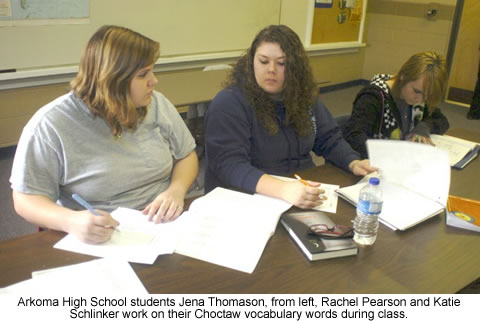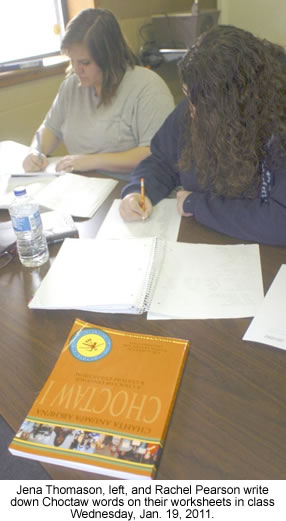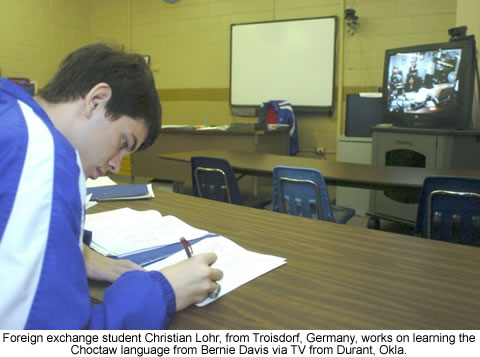 |
Canku Ota
|
 |
|
(Many Paths)
|
||
|
An Online Newsletter
Celebrating Native America
|
||
|
February
1, 2011 - Volume 9 Number 2
|
||
|
|
||
|
Choctaw Language
Classes Popular
|
||
|
byMary L. Crider - (Fort
Smith, AR) Times Record
|
||
|
credits: photos by Carrol
Copeland - Times Record
|
|
Before class and during review sessions, they and seven other Arkoma 10th- through 12th-grade students in the morning Choctaw Language class consulted one another and their workbooks regarding their lesson on kinship terms. Fourteen more Arkoma students take an afternoon class, said Arkoma coach Chester Johnson, who oversees the class. Although four students dropped from the afternoon class this year, the 2-year-old program is growing in popularity, Johnson said. Last year only three students took the class, which is offered as an Indian Education program and as a foreign language option, he said. It is one of several Indian Education programs offered at the Arkoma School District and funded through or by the Choctaw Nation, High School Principal Cyal Walden explained by note. Most of the Indian Education programs offered at Oklahoma schools are federally funded Title VII programs, the portion of the No Child Left Behind act focused on Indians, native Hawaiians and native Alaskans. Walden said the Choctaw Nation provides teachers, books and resources for students seeking a foreign/native language credit through the Choctaw language distance learning class. Arkoma faculty members monitor the students, but the Choctaw teachers provide the lessons, work and instructions, he said. At the end of the year, the tribe invites the students to hear Choctaw Nation guest speakers. Food and prizes are provided, too. The two-year language program is offered as Choctaw I and Choctaw II. Walden said tribal officials recently told the school the tribe now offers scholarships for students who complete the program and want to seek a degree to teach the language.
The Star program provides incentives to eligible Choctaw students for good grades and perfect attendance. Those who earned all A's or all A's and B's receive a certificate and a Wal-Mart gift card, Walden said. The Summer Youth program provides 14-year-old and older Choctaw students and students holding certificates of degree of Indian blood with opportunities for paid summer jobs. It benefits the students and the community, Walden said. The Johnson-O'Malley program, funded through the federal Johnson-O'Malley Act of 1934, is in its first year at Arkoma, Walden said. The act aims to ensure Indian children receive educational opportunities otherwise not provided by public schools. The JOM program requires oversight by a parent committee made up of parents of Choctaw students attending the school. The committee and the JOM director determine areas of need for the students and solutions for those needs. The program helps with funding. This year, Walden said, the focus is on school supplies, aid with extracurricular activity dues and fees, attendance incentives and field trips focused on Native American culture. According to the Oklahoma State Department of Education, more than 130,000 American Indian students attend Oklahoma public schools and more than 400 Oklahoma public schools offer Indian Education programs. The Cherokee Nation contracts with the U.S. government to provide the JOM program within its 14 county tribal jurisdiction, and the Choctaw Nation contracts to provide it within its 101/2-county tribal jurisdiction. Cherokee jurisdiction includes Sequoyah County. Choctaw jurisdiction includes LeFlore County. According to Cherokee Nation literature, its JOM program serves 19,300 eligible Indian children in 76 schools and five community based programs. According to Choctaw Nation literature, its JOM program serves 8,640 students in 68 schools. The nations don't limit participation to members of their own tribes. Although American Indian students must be served first, if space is available, other students may participate, Pocola Elementary School counselor Linda Shoemake said. Shoemake oversees the Indian Education program at Pocola. Pocola offers two types of Indian Education - an after school tutoring program at the high school and programs that incorporate Native American culture at the middle school and elementary, she said. Indian
Heritage Davis pondered for a moment, said she didn't think so, and the class watched by video as she left her desk, seeking a reference source to verify her answer. On her return, Davis told the students "telling a story" is likely the phrase that would be used. Johnson said a Choctaw noun often has several meanings, and the meaning is determined by context. For example, "holisso" can mean "book" or "letter" or any kind of paper item, he said. Johnson said when he was assigned to the class for a second year, he made it a goal to learn the language. Davis, he said, considers Choctaw her first language. She is Choctaw.
Lohr said the principal added the class to his schedule when he saw that Lohr already spoke three languages - German, English and French. He said he enjoys it. Thomason said she took Choctaw because she thought it'd be interesting. She'd taken Spanish for a year and thought it was boring. Thomason said she is about a fourth Cherokee by heritage. Devon Martin said he too thought the class would be interesting and could add another language to his credits. He previously studied Spanish. "It is good just to have it, and just in case you run into someone who speaks it," Martin said of the language. In Martin's case, running into a Choctaw speaker is likely. He is of Choctaw heritage. Pearson is Choctaw, too, and holds a CDIB card. She is the only one of her classmates to have a CDIB card, she said. Tim Freeman, a former Northside High School student, said he is also of Choctaw heritage. However, Freeman said, he found the Latin he studied at NHS to be easier to learn than Choctaw. Schlinker said her heritage is primarily Irish and German. She didn't choose the class, she said, but she likes it. |
|
|
||
|
|
||
| Canku Ota is a free Newsletter celebrating Native America, its traditions and accomplishments . We do not provide subscriber or visitor names to anyone. Some articles presented in Canku Ota may contain copyright material. We have received appropriate permissions for republishing any articles. Material appearing here is distributed without profit or monetary gain to those who have expressed an interest. This is in accordance with Title 17 U.S.C. Section 107. | ||
|
Canku Ota is a copyright ©
2000, 2001, 2002, 2003, 2004, 2005, 2006, 2007, 2008, 2009, 2010,
2011 of Vicki Barry and Paul Barry.
|
||
 |
 |
|
|
The "Canku
Ota - A Newsletter Celebrating Native America" web site and
its design is the
|
||
|
Copyright ©
1999, 2000, 2001, 2002, 2003, 2004, 2005,
2006, 2007, 2008, 2009, 2010, 2011
of Paul C. Barry.
|
||
|
All Rights Reserved.
|
||
 ARKOMA
— Students Jena Thomason, Rachel Pearson and Katie Schlinker
answered almost every vocabulary question aloud in Choctaw as their
Durant, Okla., teacher asked questions by a video link Wednesday.
ARKOMA
— Students Jena Thomason, Rachel Pearson and Katie Schlinker
answered almost every vocabulary question aloud in Choctaw as their
Durant, Okla., teacher asked questions by a video link Wednesday. Additional
Programs
Additional
Programs Johnson
said he thinks most of the students in his language classes have
Indian heritage, possibly excepting only the three foreign exchange
students in the morning class - Jacob Dohnal of the Czech Republic,
Lucas Campagnolo of Brazil and Christian Lohr of Germany. All the
exchange students attending the high school attend the Choctaw class.
Johnson
said he thinks most of the students in his language classes have
Indian heritage, possibly excepting only the three foreign exchange
students in the morning class - Jacob Dohnal of the Czech Republic,
Lucas Campagnolo of Brazil and Christian Lohr of Germany. All the
exchange students attending the high school attend the Choctaw class.